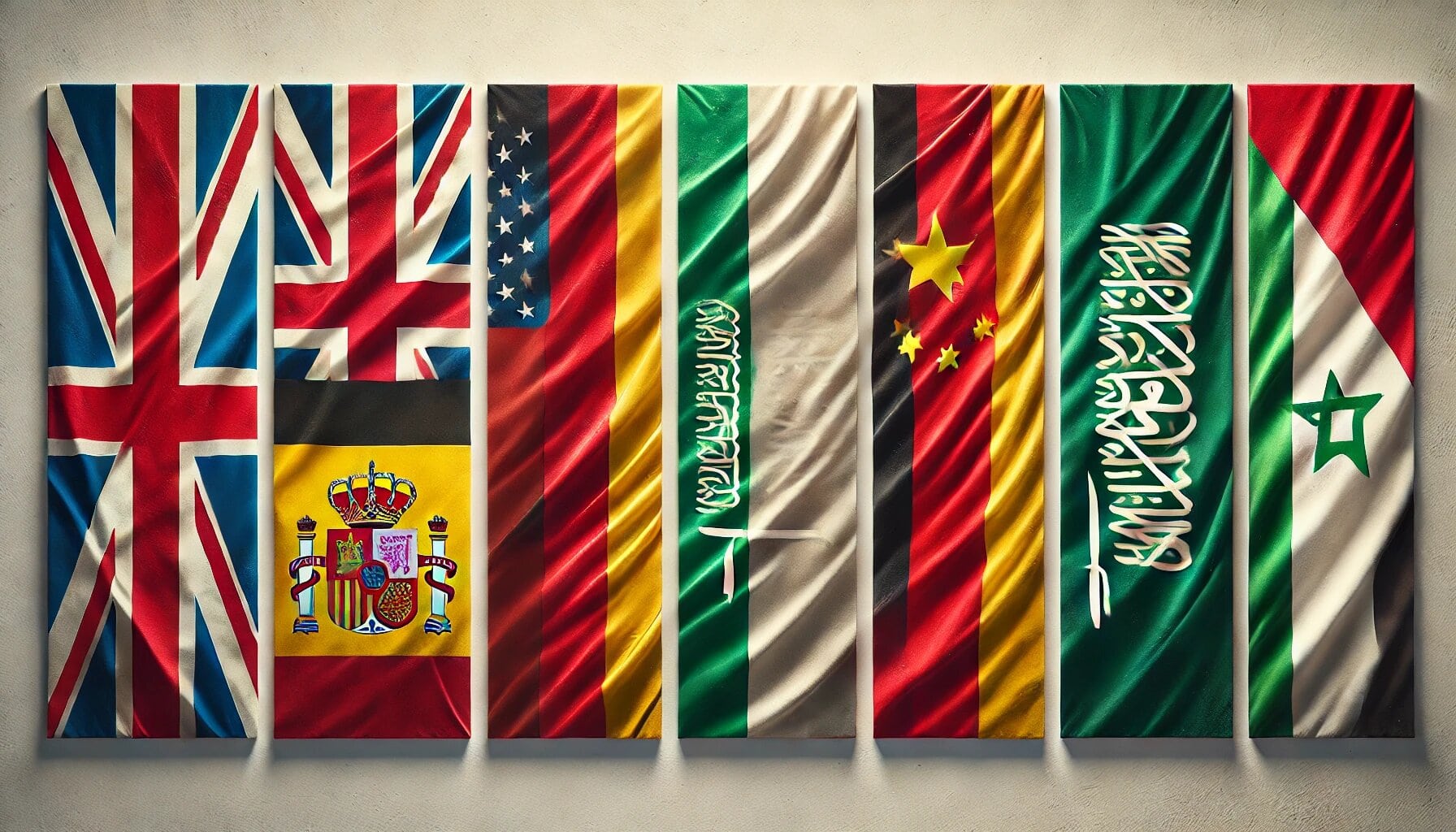You’ve mastered the local market, and now you’re setting your sights on new regions. But here’s the thing—going global means a lot more than just carelessly throwing your product into a translator. Choosing the right language isn’t just a box to tick: it’s the key to truly reaching customers across borders. If you get it wrong? Let’s just say your clientele will be hitting that "close tab” button faster than you can say bonjour.
Remember, a solid localization strategy isn’t just about moving products; it’s about making smart choices with language to really connect. Want to learn more? Let’s set out to explore why selecting the right languages matter, how to choose wisely, and which languages top the list for global localization success.
What Is Localization and Why Is It Important?
Here's something that you might want to consider: a recent survey by Statista reveals that 73% of online shoppers prefer product descriptions and reviews in their native language, and 40% would opt against buying a product if it's presented in a different language. This makes language localization — adapting content or products to fit the language and cultural preferences of a specific region/audience — an indispensable tool for international expansion of your business. Think of it as tailoring a suit for a new client: get it right and they'll be back for more.
Understanding the Localization Process
Localization involves making your product feel at home in any market, but how does it actually happen? Think of it as tailoring a suit—it’s about customizing every detail for a perfect fit. Here’s a quick overview of what goes into a successful localization process:
Language Translation: Make your content clear and natural for the target audience's language.
Cultural Adaptation: Adjust visuals, references, symbols, and whatnot to align with local expectations.
Technical Formatting: Make sure dates, currencies, and measurements match your chosen region/country.
Quality Assurance: Double-check everything before launch.
Each of these steps will make sure that your localization isn't just good, it's efficient and delivers the results you are looking for.
Benefits of Effective Localization
Spoiler alert: localization is not just about revenues. Here's why it's worth launching a localization project for your business.
Maximized Business Reach
Speaking the same language is one of the most effective ways to draw new customers. People are much more likely to notice your brand or product if you appeal to them directly in their native language. And you already know what a bigger customer base means. Moreover, customer retention becomes easier and cheaper when you employ a comprehensive localization strategy. Thus, your global reach grows exponentially.
Higher User Engagement
Social media and online reviews are massive drivers of success, especially when you start from the ground up in a new locale. Effectively communicating with your customers in a language they understand makes them feel more at home, they feel welcome, and are more likely to engage with your content, both online and offline. A study conducted by CSA Research proves that 72.4% of consumers are more likely to buy products with information in their native language. Meanwhile, 56.2% prioritize native language information over price. Just something to keep in mind.
Better Brand Perception
This point is pretty easy—people notice you more when you relate to them and what they want. A great success story is Coca-Cola (yes, even massive companies like this need an effective localization strategy). When launching in China, the soft drinks giant adapted both its name and marketing campaigns. Rendered in Chinese, the company's name is "Ke Kou Ke Le" (in pinyin, the most common romanization system for the language), which roughly translates to "tasty happiness". Coca-Cola also made sure to pay extra attention to the local customs, holidays, and celebrations to ensure that its brand growth and thrives in this key non-western market. The result? Nowadays, Chinese consumers enjoy 150 million servings of all Coca-Cola beverages across the country every single day.
How to Choose the Right Localization Language?
With the basics down, we can move on to the meat of this article: choosing a top language for your localization project. The choice largely depends on three key factors:
Funds at hand
Workforce at your disposal
Your ambitions
These are the variables that you are in charge of. But there are also things beyond anyone's control that need to be accounted for when choosing a particular language. Let's take a closer look at them.
Factors to Consider When Choosing a Language for Localization
Specific Demographics
Research the linguistic composition of your target region to better understand the challenge ahead. The important thing to remember here is that countries and languages are not always homogeneous. Sometimes a single country has more than one official language. A good example is Belgium, a country that operates in French and Dutch, two languages that belong to different linguistic groups, making it complicated to present a unified marketing message. On top of that, all products sold in Belgium must feature both of these languages on their packaging. This little detail will ensure that you are armed with the best localization strategy to enter the Belgian market (and with French and Dutch localizations, it will be easier for your business to move into France and the Netherlands, with certain tweaks of course to account for cultural differences).
Another important point is targeting a vast region. A company looking to make it big in South America might focus solely on Spanish—after all, 9 out of 12 South American nations have Spanish as their official language. However, you shouldn't forget about Brazil and Brazilian Portuguese (which by the way is in a few ways different from Portuguese spoken in Portugal). On top of that, the Latin American region has a number of spoken native Indian languages like Quechuan, Aymaran, Tupí-Guaraní, and Mapuche. Albeit small in terms of the number of speakers, adapting your localization strategies to these certain languages might win your company a very loyal customer base, which will appreciate the extra effort you make to make your offers accessible to them.
Language Complexities
Some localizations might come easy to your business. If your primary language of operations is Swedish, localizing into Norwegian and Danish won't be a challenge at all. Same goes for Slavic languages, a transition from Slovak to Czech will be rather straightforward. This is because these languages belong to the same branches. Some examples are Germanic, Romance, Sino-Tibetan, Bantu, and more.
The problem comes when you switch to a different language group. An English-based business might struggle big time when it comes to entering the Japanese market or a country that speaks Arabic. Languages are not only complex, they use different writing systems, special sentence-forming rules, and a different set of characters to the Latin script. Businesses should conduct an in-depth research of the target language and check whether their resources match the requirements of these cases.
Companies need to keep an eye on more than just the language—think of it as checking the "backstage" before the big show. That means having skilled translators, the right localization tools, and a solid crew to make the magic happen. Sometimes, though, it’s best to call in the pros: outsourcing to a top-notch agency can be the difference between a flawless performance and a few awkward stumbles on stage.
Languages and Cultures
Last but not least we have cultural aspects. Did you know that number 4 in China is considered unlucky? That is because the way it is pronounced in the Cantonese dialect is nearly homophonous to the word "death". In some Chinese and East Asian buildings you won't even find rooms and floors containing number 4! Another interesting fact is that Disney changed the lyrics of a song used in their recent remake of Aladdin from "Sunday salaam" to "Friday salaam" because Friday is considered a holy day in Islam.
These are examples of cultural sensitivities that an effective localization strategy will need to factor in if the project is to be a success. We can only offer one piece of advice here: research, research, and research.
Understand Your Target Market
There's one central theme in all localization efforts, whatever language is chosen: connect with your target audience. Try to understand how they think, what they yearn for, how likely they are to embrace your business. This is important for both launching the expansion and long-term growth and success of a company moving outside of their linguistic comfort zone, so to speak.
Popular Localization Languages for Your Project
Any business looking to prove themselves on an international stage has asked this question: what languages should I choose for my localization(s)? Our brief guide to the most widespread and popular localization languages is here to help you. Let's dive right in to find out what the right languages for your localize efforts are.
Most Popular Languages for Localization in 2024

English
With a whopping 1.5 billion speakers across 106 countries, English is practically the universal handshake of global business. It’s officially claimed by over 50 nations, so if you’re aiming for worldwide fame, English is your backstage pass. But beware: English isn’t one-size-fits-all. For example, between US, UK, and Aussie English, chips, crisps, and fries can all refer to the same thing with slight variations. So, localize with care, or risk serving your audience some very confusing messages.
Mandarin Chinese
Mandarin flaunts a cool 1.1 billion speakers, mostly across China and Taiwan—talk about a language with serious crowd appeal! It’s China’s official tongue, making it a must-have for any business with big plans in the region. But heads up: Mandarin isn’t just one script fits all. Simplified Chinese rules in mainland China, while Traditional Chinese holds the stage in Hong Kong and Taiwan. Get it right, or you might just leave your audience scratching their heads.
Spanish
Spanish, with its 486 million speakers and official status in 20 countries, is like the VIP pass to Latin America and Spain. For businesses making moves in these new markets, going Spanish isn’t just smart—it’s essential. But watch out for the flavor variations! European Spanish and Latin American Spanish each have their own twists and turns, so localize wisely, or you might accidentally serve up a linguistic tapas that leaves your audience puzzled.
French
French, with around 320 million speakers and official status in 27 countries, is your gateway to markets from France to Canada and much of Africa. It’s one of the world’s most widespread languages, and for businesses going global, it’s practically a must. But don’t forget that the French spoken in Paris isn’t quite the same as in Montreal or Dakar. Keep those regional nuances in mind, or you might just leave your audience with a cultural faux pas!
Arabic
Arabic, with its 274 million speakers and official status in 26 countries across the Middle East and North Africa, is a language powerhouse. If you’re looking to make waves in these regions, Arabic is your ticket in. But beware—Arabic isn’t just one language; it’s practically a whole family reunion of dialects! To keep things clear, stick with Modern Standard Arabic, the common ground that’ll make your message shine from Cairo to Casablanca.
German
German rolls out the red carpet for around 132 million speakers and is the official language in six countries, including Germany, Austria, and Switzerland. As the EU’s most spoken native language, it’s a must-have for businesses eyeing the European stage. But heads up—German comes with its own quirks, from Swiss German to Austrian German. So, keep it regional if you want to charm your audience and avoid serving up any “lost in translation” moments!
Here's a handy table for you to quickly assess the force that each of these languages are:
| Language | Number of speakers | Сountries with official status | Language family | Main varieties |
|---|---|---|---|---|
| English | 1.5 B | 57 | West Germanic | US, UK, Australian |
| Chinese | 1.1 B | 2 (+3 territories) | Sino-Tibetan | Mandarin, Cantonese |
| Spanish | 486 M | 20 | Romance | Castellano, Andaluz, Mexicano |
| French | 320 M | 27 | Romance | Metropolitan, Belgian, Canadian, Abidjan/Ivorian |
| Arabic | 274 M | 24 | Central Semitic | Egyptian, Gulf, North Levantine |
| German | 132 M | 6 | West Germanic | Standard, Austrian, Swiss |
What Role Do Localization Services Play in Your Project?
Once you've chosen the language(s) to localize your project in, the work really begins. However, it is sometimes daunting to juggle translators and their input, deadlines, developers, and ongoing business operations. A huge help in this process comes from Translation Management Systems (TMS). By bringing them into the mix, you automate workflow, standardize procedures, simplify project monitoring, and speed up the project.
Choosing the Right Translation and Localization Partner
The market is saturated with automated translation services that will get the job done. The difference lies in specific circumstances of your business. Some systems will offer a wide range of integration options, some will be ultra fast, some will offer a variety of premium tools. But most companies are after one specific feature: high quality for low price. And that's where Localit comes into play.
Localit is a brand new AI-driven localization software that is designed for businesses and startups that value speed, precision, and efficiency. Being the brainchild of an experienced tech team, Localit understands the challenges of effective localization. The software was initially created as a support mechanism for the team’s future projects but later transformed into a full-blown, ready-to-use solution that can be successfully used by:
Businesses looking to scale and grow
Developers to focus on their primary work
Managers to track project progress
Translators to simplify their work routine
Localit boasts a number of competitive advantages that will help your localization project to succeed:
Low prices: There is a free plan to test Localit's functions, while yearly plans start at just $9 per month.
High-speed: The processing speed of the platform reaches 200 m/s, you can download your large project into the system faster than it takes you to make a cup of coffee.
Built-in chat: Forget about switching between Slack, Teams, and Gmail to message members of your team, communicate directly on the platform with an instant notification system and the ability to send voice notes, photos, screenshots and more.
Wide range of languages: Localit currently supports 111 languages for localization, but the number will only keep getting larger.
AI-driven machine translation: The system supports integration with ChatGPT, Google Translate, DeepL, and Gengo for you to choose your favorite translator.
Modern interface: Localit is a cutting-edge software that is intuitive and easy to use by developers, managers, and translators alike.
Any project needs a helpful tool to achieve its goals. Head over to Localit's website and take its features for a test drive. Get in touch to learn more about what Localit can do for your business.
Localize, Translate, Succeed
Choosing the right language for localization isn’t just a checkbox—it’s a strategic step toward global greatness. And when it’s time to bring your vision to life, Localit is here to make the magic happen, transforming translation from a headache into a smooth, streamlined process. So, go ahead and make the leap; with the right language and tools in hand, your business is set to thrive in markets you haven’t even imagined yet. Localize, translate, succeed—let Localit show you how!

 The Ultimate Guide to Software Localization: Localize Software with Best Practices
The Ultimate Guide to Software Localization: Localize Software with Best Practices AI Localization: How Artificial Intelligence Is Changing the Landscape of Localization and Translation
AI Localization: How Artificial Intelligence Is Changing the Landscape of Localization and Translation Localization Industry in 2025: Key Trends, AI, and Future of Translation Explained
Localization Industry in 2025: Key Trends, AI, and Future of Translation Explained